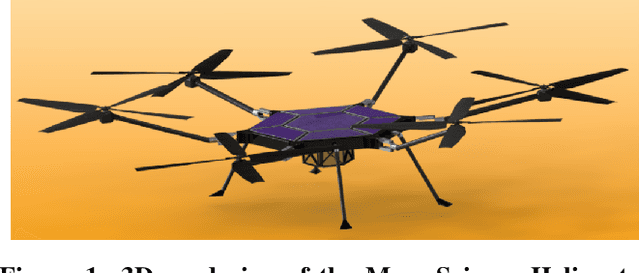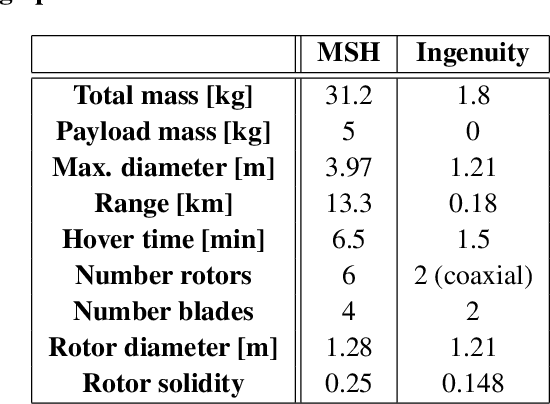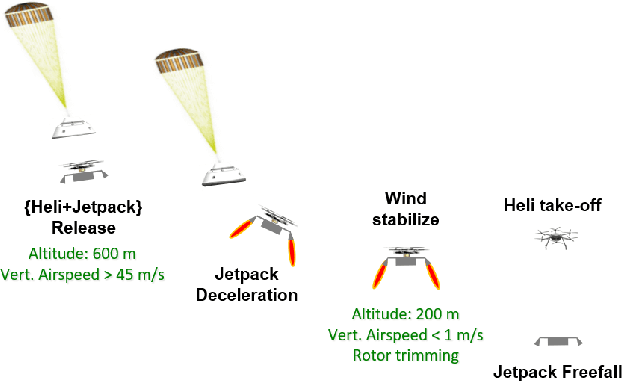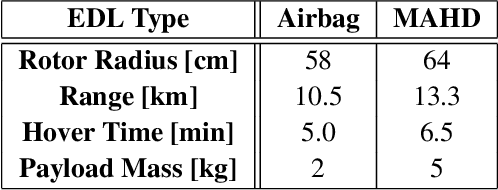Juergen Mueller
Bob
Mid-Air Helicopter Delivery at Mars Using a Jetpack
Mar 07, 2022



Abstract:Mid-Air Helicopter Delivery (MAHD) is a new Entry, Descent and Landing (EDL) architecture to enable in situ mobility for Mars science at lower cost than previous missions. It uses a jetpack to slow down a Mars Science Helicopter (MSH) after separation from the backshell, and reach aerodynamic conditions suitable for helicopter take-off in mid air. For given aeroshell dimensions, only MAHD's lander-free approach leaves enough room in the aeroshell to accommodate the largest rotor option for MSH. This drastically improves flight performance, notably allowing +150\% increased science payload mass. Compared to heritage EDL approaches, the simpler MAHD architecture is also likely to reduce cost, and enables access to more hazardous and higher-elevation terrains on Mars. This paper introduces a design for the MAHD system architecture and operations. We present a mechanical configuration that fits both MSH and the jetpack within the 2.65-m Mars heritage aeroshell, and a jetpack control architecture which fully leverages the available helicopter avionics. We discuss preliminary numerical models of the flow dynamics resulting from the interaction between the jets, the rotors and the side winds. We define a force-torque sensing architecture capable of handling the wind and trimming the rotors to prepare for safe take-off. Finally, we analyze the dynamic environment and closed-loop control simulation results to demonstrate the preliminary feasibility of MAHD.
Adaptive kNN using Expected Accuracy for Classification of Geo-Spatial Data
Dec 14, 2017



Abstract:The k-Nearest Neighbor (kNN) classification approach is conceptually simple - yet widely applied since it often performs well in practical applications. However, using a global constant k does not always provide an optimal solution, e.g., for datasets with an irregular density distribution of data points. This paper proposes an adaptive kNN classifier where k is chosen dynamically for each instance (point) to be classified, such that the expected accuracy of classification is maximized. We define the expected accuracy as the accuracy of a set of structurally similar observations. An arbitrary similarity function can be used to find these observations. We introduce and evaluate different similarity functions. For the evaluation, we use five different classification tasks based on geo-spatial data. Each classification task consists of (tens of) thousands of items. We demonstrate, that the presented expected accuracy measures can be a good estimator for kNN performance, and the proposed adaptive kNN classifier outperforms common kNN and previously introduced adaptive kNN algorithms. Also, we show that the range of considered k can be significantly reduced to speed up the algorithm without negative influence on classification accuracy.
Gender Inference using Statistical Name Characteristics in Twitter
Jul 01, 2016



Abstract:Much attention has been given to the task of gender inference of Twitter users. Although names are strong gender indicators, the names of Twitter users are rarely used as a feature; probably due to the high number of ill-formed names, which cannot be found in any name dictionary. Instead of relying solely on a name database, we propose a novel name classifier. Our approach extracts characteristics from the user names and uses those in order to assign the names to a gender. This enables us to classify international first names as well as ill-formed names.
 Add to Chrome
Add to Chrome Add to Firefox
Add to Firefox Add to Edge
Add to Edge